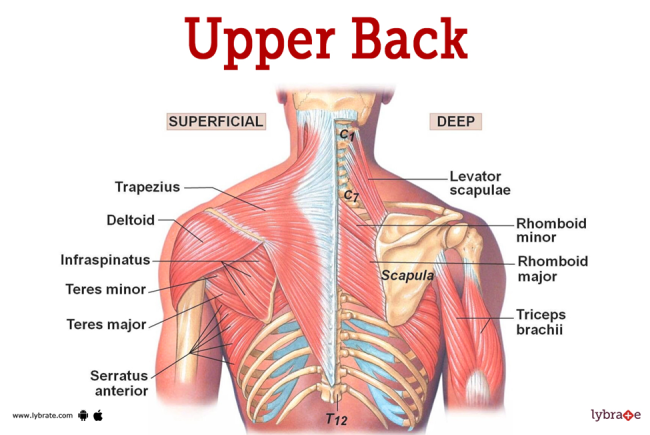Upper Back Anatomy
By Shania Rayford, CGEI
Our back is a very complex region of muscles that is responsible for a lot of daily activity. Your back keeps you erect, assists in breathing, and aids in the movement of your other limbs. Muscles of the back are either superficial, meaning closest to the skin, or deep which are closer to the middle. Specifically, today I will cover a muscle of the upper back called the trapezius. This unique muscle earned its name due to the shape resembling a trapezoid.
Image:
https://www.lybrate.com/topic/upperback-image
The trapezius muscle is a superficial muscle that covers the neck, shoulder, and mid-back region. It allows you to maintain good posture, stabilize shoulders, shrug your shoulders, internally rotate your arms, and throw things overhead. It has 3 regions of fibers; upper, lower, and middle. The upper group of fibers help keep the neck extended and erect. The lower region assists in bringing down the scapula. Lastly, the middle fibers are responsible for bringing your scapula towards the midline of the body.
The trapezius is responsible for numerous tasks like picking up a bag or throwing a baseball. Although the trapezius is not the only muscle involved in such tasks, without it they could be almost impossible to carry out. Think of a construction crane, the base being your trapezius, and the claw resembling your arms and hands. The base keeps everything stable and in place to bear the load of your arm and whatever is being picked up. Without the strength of the base holding everything in place, the arm will be of no use.
It is important not to neglect your back in your strength training programs due to the importance it has on many daily tasks. Next time you shrug your shoulders at back day, keep in mind what muscle you used to carry out that motion, and what life would be like if it lost its ability. Continue to Move Well!
Citations:
Ourieff J, Scheckel B, Agarwal A. Anatomy, Back, Trapezius. In: StatPearls. StatPearls Publishing, Treasure Island (FL); 2023. PMID: 30085536.
https://europepmc.org/article/NBK/nbk518994
https://my.clevelandclinic.org/health/body/21632-back-muscles
